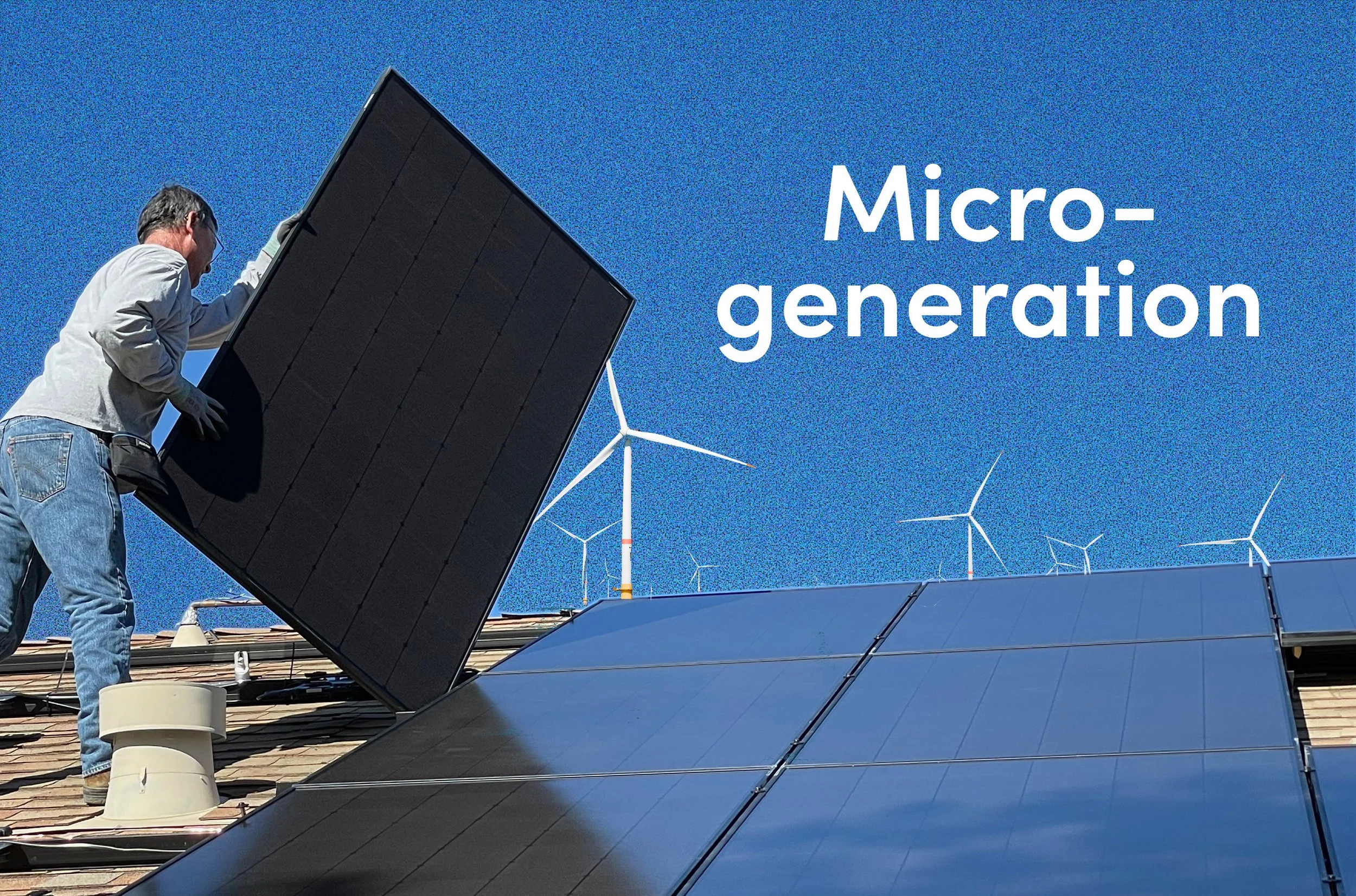Microgeneration, Carbon Capture and the Green Rush
ENERGY EVERYWHERE
Telegraph and telephone communications were made possible by extensive wired networks. Then came the mobile cell phone and our reliance on cable networks has diminished. Some developing countries skipped the wired communications era altogether and instead are mostly now relying on mobile technology.
A similar situation for power generation, transmission lines and substations is likely. Advances in solar cell technology, micro wind, geothermal, smart buildings, and even energy created from human beings, challenge the traditional power grid model. Instead of giant power stations transmitting power hundreds of miles away, what if power could, at least in part, be generated right where it's needed? This is microgeneration.
Microgeneration
Microgeneration solutions could be everywhere and dispense with the need for big power stations and distribution lines. The most obvious example is solar panels combined with a home battery storage pack, providing self-sufficient power and even a net contribution to the grid. Integrated solar everywhere from roof, glass and even car opens the potential to produce a significant percentage of our future energy from microgeneration.
It's not just about solar, small wind turbines and geothermal generation could make many buildings independently powered.
Tapping into the sun's energy is not just about solar cells; capturing the heat generated from the sun, known as solar thermal fuels, can capture heat in a chemical reaction to be released later for energy.
Even just walking can generate power, with companies like Pavegen that have developed a floor which slightly vibrates when people walk on it generating electricity.
Combining microgeneration solutions and renewable technologies with battery storage and vehicle or device to grid could create what is known as the ‘intelligent grid’. Energy can be shared, generated, and stored from thousands of sources rather than just power stations. Internet of things (IOT) devices all connected intelligently could help load balance demand, even your smartphone could potentially feedback its power when you're not using it. On a massive city sized scale, with millions of people, these solutions would be significant.
Some of these concepts are still a long way off, but one is already in use with the potential to go mainstream: vehicle to grid or V2G. However, not every country currently allows domestically produced power to be pumped back into the grid, and not every electric car is capable of two-way power yet.
Instead of having a power wall for peak power installed in your home, your car could do that job, therefore offsetting the reliance on fossil fuel power stations.
So just how mainstream are V2G solutions? If you already have solar panels or a wind turbine at your home feeding electricity back into your electricity supplier, then VTG is possible. With some slight modifications to your electrical supply at home you can run power back into the grid, although the car must be capable of that first.
The cost of V2G home solutions is still relatively expensive but costs are expected to drop. V2G solutions offer a form of load balancing on a mass scale and this could create the concept of an energy ‘grid of things’!
As I said though, not all electric cars offer a vehicle to grid option. Tesla cars don't yet have this capability and have so far declined to entertain it as a possible future option. It could be argued that vehicle to grid would compete with Tesla's own Powerwall business. But if commercial pressure proves overwhelming, much like the newly announced availability of some Tesla Superchargers to other manufacturers, well, you could never argue that Elon Musk is not commercially minded…
CARBON CAPTURE
Carbon is the basis for all life on earth. Living or dead, plants and animals store and emit carbon. However, with the expected growth in population, plus demands for energy, the great electric transition will not be fast enough to lower our carbon emissions in time to avoid climate disaster.
What if we could just take carbon from the atmosphere and store it?
Carbon capture technology has gained a great deal of attention in recent years for obvious reasons. So, are these futuristic dreams or near realities?
There are three main carbon capture approaches, the first is at emissions source, the second from the atmosphere and the third with natural biosphere methods.
At source methods have been used for decades to control factory emissions. They are prohibitively costly thus preventing mass use to date. Despite being around for years the technology hasn’t evolved much until recently, but now many new concepts and prototype devices are in the works. Elon Musk even offered $100 million towards a prize to come up with the best carbon capture technology.
Carbon capture, utilization and storage known as (CCUS), has been operational in many large-scale industries since the early 1970s. The oil industry for example has been pumping carbon dioxide into the ground to help extract more oil. Selling CO2 from air capture to oil companies to make oil wells more productive might seem counterintuitive. Known as Enhanced Oil Recovery (EOR), its use is one criticism by environmentalists of carbon capture business models. Ironically CCUS projects peaked around the year 2010 and then began a decline until more recently as investments in the technology
resumed. These carbon capture technologies involve pumping excess carbon production underground in storage spaces and caves.
Carbon Capture Storage (CCS) aims to trap CO2 emissions in a liquid form before they enter the atmosphere. A conglomerate of some of the world's largest oil companies have built CCS plants in Norway capable of capturing 100,000 tons of carbon per year.
These high-cost solutions are currently massively loss making, however far less costly than dealing with the consequences of climate change. The International Energy Agency (IEA) estimates that CCS technologies could be capable of capturing 20% of the world's carbon dioxide emissions, but that would require a huge international investment. CCS technology alone therefore cannot deal with our 50 billion tons of carbon dioxide emissions per year.
The second solution is to try and collect carbon directly out of the atmosphere. Direct air capture technology focuses on capturing the low concentration CO2 from the air. These methods work by sucking in air with a big fan, then using chemicals to extract and concentrate the CO2 to produce solid, often calcium based, pellets which can be stored or mixed in products like concrete.
Big oil companies, like Exxon, have formed partnerships to advance technologies to try and bring large scale breakthroughs that can remove carbon dioxide. Captured carbon could then even be stored in empty former oil fields underground. The cost of air capture is more than fifty times the cost of a natural biologic solution like tree planning, but drawing down carbon from the atmosphere is still a worthy endeavor with startups like SeeO2, Carbon free, Carbon engineering, Carbonworks and Deep Branch all pioneering differing technologies.
Sequestering atmospheric carbon can be done by human invention or the natural way by using the Earth’s own carbon storage technology – by growing stuff! This is known as biological carbon capture.
Many companies use tree planting projects to offset their carbon emissions. Trees, grass, wetlands, the sea and the soil all absorb carbon dioxide.
Modern farming and tilling techniques are stripping our topsoil bare and releasing millions of tons of carbon, while organic methods of farming help reverse this. Protecting forests, wetlands, mangroves, river deltas and bogs also prevent carbon release.
Reducing meat consumption and developing plant-based meat substitutes in addition to reducing food waste are also important steps.
The planet can self-heal and enabling biodiversity to return will help to offset our negative climate activities. Tree planting helps the problem, but we can never plant enough trees to sequester all the carbon in the atmosphere. Worse still, we are continuing to deforest huge areas, with over 10% of the Amazon lost in the last 10 years.
All these actions, including carbon drawdown, are now a necessity as simply just lowering our carbon emissions is not enough to limit warming.
Accelerating these initiatives takes money, lots of money and the good news is that the investment world and governments are waking up to the challenge and opportunity.
GREEN RUSH
Solving our climate crisis should be regarded as one of the greatest investment opportunities since the gold rush or age of oil. We are at the beginning of a great green revolution and the opportunities are boundless. Instead of worrying about jobs and skills being lost as the car industry transitions to electric or the oil industry transitions to renewables, we should be looking at the massive opportunities for new employment, new skills, and progress.
Billions of dollars are now beginning to pour into this green rush. Large investment firms, pension trusts, venture capital and private equity have launched large ESG (Environmental, Social and Governance) and green technology funds.
Firms like US Blackrock, the largest investment firm in the world, announced a $600 million fund in early 2021 to invest in firms working to reduce carbon emissions. Funds dedicated to green tech investments have surged more than 50% to over $1.3 trillion dollars.
Joe Biden’s administration’s doubling of carbon saving targets, to a 50% reduction by 2030, opens the potential for the green rush to become a stampede of investment. Climate Capital is now big business and going to get much bigger.
It’s not just investment funds, corporations are getting in on the action too. Microsoft, for example, announced that they are launching a $1 billion climate innovation fund to accelerate the development of carbon reduction and removal technologies.
Climate capital is a ‘mega-trend’ gaining momentum. More and more companies are looking for a more sustainable operating model. Growing public attention on those companies that do not meet green goals or have strong green initiatives could see customers turn away. Corporations are not blind to this and what was once lip service is now becoming real investment intent.
What was normal and accepted in the past will not be accepted for much longer; investing in hydrocarbon-based companies was once sound investment advice, but their ability to produce multiples of return is waning as hotter, more exciting cleantech alternatives emerge. Firms like BlackRock have declared that oil and gas investments may not be good ideas going forward. As the saying goes ‘follow the money.’
Achieving 100% electric cars and clean energy is an enormous task but not impossible. The progress in the first fifth of this century has been staggering. Our air and climate future may become a lot cleaner and brighter. Good news for us all.





